Daniel Canogar is a media artist living between Spain and Canada. He’s also the Artistic Director of VIDA, an international competition on art & artificial life. Launched 10 years ago by Fundación Telefónica, the prize rewards works of art produced with and commenting on artificial life technologies.

Previous winners include projects as different as a robot that sweats, a table that follows you around, robotic dogs suffering from the mad cow disease, solar-powered devices which modify their own instruction code in response to environmental changes, autonomous non-violent protest agents, a mobile cemetery tank, a Universal Whistling Machine, etc. What these artworks have in common is that they engage with emerging behaviours, which evolve over time, react with their environment and seem to have a life of their own.
The dozens of projects which have received an award over the past ten years form a unique collection documenting the evolution of electronic art in one of its most significant aspects. The looming deadline to submit projects (6th of October 2008) is the excuse i took to interview Daniel Canogar about the competition.
Last year the VIDA competition celebrated its 10th anniversary. How did it evolve over the course of the years? Did it get more ambitious? Set itself new goals? Opened its scope to new territories? i’m thinking about last year’s winner, NoArk by Symbiotica, which is not based on electronics but on biotechnology.
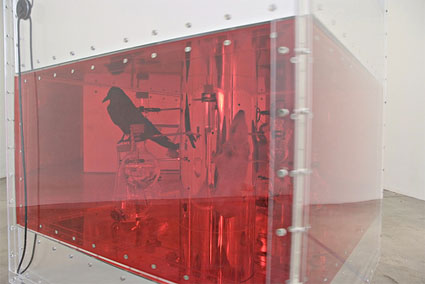 Oron Catts and Ionat Zurr, Noark (VIDA 10.0)
Oron Catts and Ionat Zurr, Noark (VIDA 10.0)
When VIDA began, A-Life as a discipline was still very recent, a little over 10 years old. So as usually happens with young disciplines, there has been an evolution in the field, which has been reflected in VIDA. A couple of years ago there was a heated discussion amongst jury members if VIDA should be open to biotechnology art projects. The origins of A-Life are in computer simulation, not biotech, so this was quite a controversial issue. In the end, we did decide to include biotechnology projects, as they are closely related to A-Life concerns. The important thing, in my view, is not to remain faithful to categories, but to keep VIDA alive with the kind of art projects that are relevant to our times.
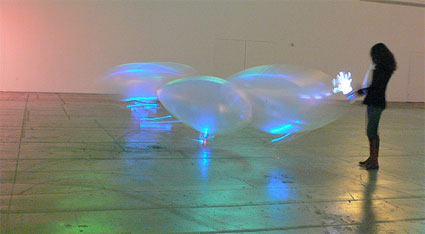 ALAVS, Jed Berk (Honorary Mention VIDA 10.0)
ALAVS, Jed Berk (Honorary Mention VIDA 10.0)
I guess this will sound like a silly question but do you see trends in the entries the prize has received over the years? For example, artificial life of animals being abandoned at some point because the trend is more in artificial life at a nano-level? How closely do the entries reflect the changes occurring in our society and in research more particularly?
It’s not art’s mission to be a direct mirror of what is going on in research labs. A-Life art has taken some of the evolutionary concepts of the field, and in a sense created a totally new field that is much closer to the general public. But more importantly, these projects are not so concerned with specific technologies generated in research labs. They are extremely concerned with concepts, ideas, questions about how technology has changed the way we feel about ourselves, about notions of what it means to be alive, or dead, etc. It is exactly the kind of conceptual questioning that is often so lacking in research labs. VIDA submissions do not come out of A-Life lab research, though their contribution to the field is extremely valuable. In fact, I hope scientists working in the field of A-Life take note of VIDA art projects, and take some of the serious questioning that occurs at a sociological and cultural level back to the lab.
VIDA rewards works of art developed with artificial life technologies and related disciplines. How much of this artificial life has already moved away from research labs and artists workshops to crawl into our everyday life?
A-Life research is present in everyday consumer products, such as children’s electronic pets (Tamagotchi, Dogz, Catz and many more), video games with characters that evolve over time, or in intelligent interfaces for mobile telephones and other electronic devices which “learn” about the user, including search engines. No doubt, in coming years such technologies will become a staple of our quotidian life.
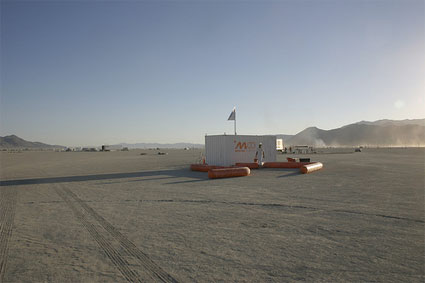 etoy.CORPORATION, Mission Eternity Sparcophagus
etoy.CORPORATION, Mission Eternity Sparcophagus
Fundación Telefónica exhibited the winners of VIDA 10.0 at the ARCO art fair in Madrid last April. Has FT always done that? I found so far that very few art fairs actually give space to art practices engaged with technology. Why is the presence of VIDA in the commercial context of an art fair so important?
Fundación Telefónica has always exhibited VIDA winners at ARCO. First of all, it is important to give ARCO, Madrid’s art fair, a little bit of context. ARCO is not like any other fair, it is a fundamental cultural phenomenon in Spain. It transcends contemporary art, arousing interest from every creative field, and people from all walks of live, young and old, rich and not so wealthy, high-school students and major art collectors. Every year about 200.000 people visit the fair. So VIDA’s presence in ARCO is a fantastic way of getting the public to learn about the award.
But beyond visibility of VIDA, there is also the art market issue. New media artists need to find alternative ways of circulating and distributing their work beyond the rather small circuit of specialized festivals and conferences. Funding of technologically driven artwork is expensive, and artists need to find ways of financing their projects. There have actually been VIDA awarded projects that have sold at the fair, and of course, the sale goes directly to the artist.
This is very encouraging. It’s a very daring thing for the Fundación Telefónica to present this kind of technological work in the context of the art fair, and through the years, Fundación Telefónica’s booth has been one of the most successful at the fair.
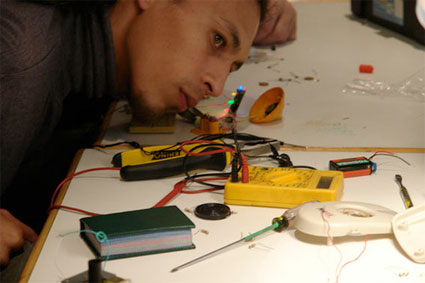 Image courtesy Daniel Canogar
Image courtesy Daniel Canogar
VIDA is also involved in a series of workshops taking place in Latin America. Can you tell us something about these workshops? How do they go? What is their objective? What happens there?
Latin America is a region where artists have a hard time funding their new media projects. Fundación Telefónica has exhibition spaces and programs in Lima, Sao Paulo, Buenos Aires, Santiago de Chile and Mexico City, so VIDA’s projects in Latin America grow out of this preexisting network. Certain places have a lively new media scene, such as Buenos Aires. In other cities, the scene is practically non-existant. Funding for VIDA workshops is conceived as seed money for potential VIDA award candidates. We want to tap into the tremendous creative talent that exists in Latin America, and also help create a context for the emergence of A-Life art. For this reason we ask VIDA award recipients to develop workshops for Fundación Telefónica’s centers in Latin America. This year Gilberto Esparza, a fantastic Mexican artist that won a VIDA award last year, has directed workshops in Buenos Aires, Lima, Santiago and Mexico City. It’s a way of creating a community of artists helping other artists create new work. This is an exciting development for VIDA.
Video of the FT workshop in Lima, Peru. Credit: Gilberto Esparza
The Incentive for Iberoamerican productions award helps artistic projects that still have not been produced. How difficult is it to judge the validity of a work which doesn’t really exist yet? How far must the artists be in the advancement of the project?
When the artist has a conceptually clear idea of what he/she wants to do with his/her art project, it usually comes through in the actual proposal. The technical description of how the work is going to get made is also important and very revealing. Many members of the jury are very savvy about both software and hardware and can usually figure out if the work can get built as described. Past work by the artist also gives the proposal more context, so we often look at dossiers or webpages. Its always really exciting to see these works actually materialized having seeing them in their infancy as proposals. And what really prides the jury members more than anything else is when we begin to see some of these art pieces circulate in exhibitions and festivals.
Were it not for VIDA and a few other initiatives i, and i’m sure many people in Europe, would know almost nothing about Iberoamerican art projects developed using artificial life technologies, electronics, robotics, etc. Do you have some advice for people curious about what is going on over there?
Well, for starters, it may be interesting to look at VIDA’s webpage with documentation of selected past projects: many of them are from Latin America. Another fantastic source of new media art made in this region is the exhibition Emergentes. Curated by Jose Carlos Mariátegui, it is one of the first exhibitions focused on Latin American new media art. This is a traveling show which opened in Laboral, the center for new media art in Gijón, northern Spain. The catalogue is a good source for references, understanding of the cultural specificity and historical background of the emergence of new media art in Latin America.
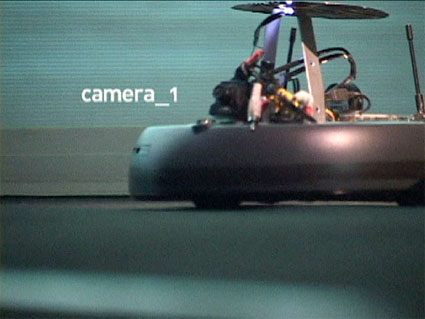 Part of the exhibition Emergentes: Spio by Lucas Bambozzi (Brasil)
Part of the exhibition Emergentes: Spio by Lucas Bambozzi (Brasil)
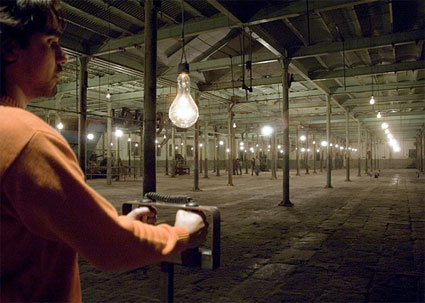 Also at Emergentes: Rafael Lozano-Hemmer, Almacén de corazonadas
Also at Emergentes: Rafael Lozano-Hemmer, Almacén de corazonadas
Can you tell us something about the project of Fundación Telefónica Virtual Museum? When will it go live? What will web users find there?
It should be available early next year. The Virtual Museum wants to be a didactic tool, the best source for A Life Art on the web, where you will not only see documentation of VIDA awards, but you will actually be able to experience some pieces first hand with web-based projects. It will also document the history of A Life art, and show many landmark projects that have significantly contributed to the field. The interface will allow for a very intuitive and seamless navigation through all this documentation. It’s a large project, one that will require constant updating to make it really alive, and hopefully become a significant reference in the new media art scene.
Over the years the competition has gained fame and visibility. How does it translate in terms of number of entries? And do you tend to receive more entries from Spain, Iberoamerica and Portugal?
Last year we received close to 200 entries from 25 different countries. There has been a steady increase of submitted projects through the years, a real accomplishment if you bear in mind how specialized the award is. Every year three projects get awards, plus 7 projects are selected as honorary mentions. That means that on VIDA’s web page, you can study an archive of over 100 art works related to A Life. About 30% of submitted projects are from Spain, Portugal and Latin America. Contributions from the US and Canada form another 30%, European projects comprise approximately 30 % and the remaining 10% are submissions from Asian countries. One of our objectives for the close future is to reach out to Japan, Korea and China, where significant A Life art has taken place in the last few years. There is always room to improve! VIDA is a unique award, the only one in the world specialized in A Life and Robotic art. I am now hoping for another 10 years of growth, enabling more artists to realize their life-like creations all around the globe.
Thanks Daniel!
